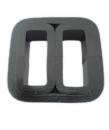
The structure of the transformer core has a direct impact on its performance. Common structures include E-type, C-type and toroidal (or circular) cores. The different structures have their own characteristics in terms of magnetic circuit design, loss characteristics and application scenarios.
The E-type core consists of multiple silicon steel sheets stacked on top of each other and is usually used in higher power transformers. The magnetic circuit design is simple and the manufacturing process is well established. the advantage of the E-core is that it is easy to process and assemble, but due to the existence of air gaps between the stacked sheets, the magnetic properties will be affected to a certain extent, resulting in a slightly higher iron loss, and it is suitable for low and medium frequency transformers.

Type C cores are formed by crimping or cutting silicon steel wafers to create a closed “C” shaped magnetic circuit. C-cores have a smaller air gap than E-cores, resulting in better magnetic properties and lower iron losses, and they are also lighter in size and weight, making them ideal for use in applications where high energy efficiency is required and size is a limitation, such as power electronics and small to medium-sized transformers.
The toroidal core is made of continuous silicon steel strip wound without air gaps in the magnetic circuit, providing the best magnetic properties and the lowest iron losses. This structure has a uniform flux distribution and low noise and vibration, and is widely used in transformers with high efficiency and low noise requirements, such as audio power supplies and instrument transformers. However, toroidal cores are more difficult and costly to process and are not suitable for high power equipment.
Made of stainless steel, shining 2022 Winter Olympics!
2022-02-23The benefits of using stainless steel tableware
2022-10-08SS Production Enterprises in Henan Province have been Shut Down
2020-12-16Countertops made in stainless steel is a good choice for cabinets?
2022-01-06New opportunities and challenges in stainless steel industry
2024-04-19Why put pebbles under the transformer?
2023-12-16






